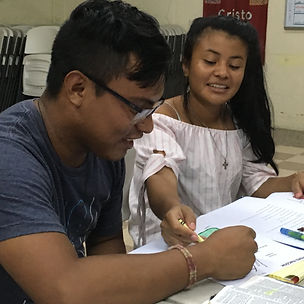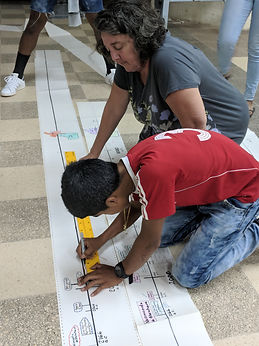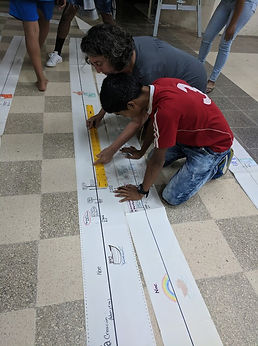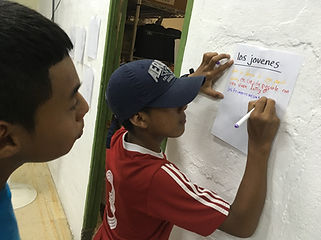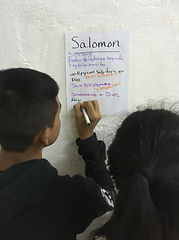
Exploring Methods of Teaching and Learning
Differentiated Lesson Plan
Common Core or State Standard(s):
CCSS.ELA-LITERACY.CCRA.R.1
Read closely to determine what the text says explicitly and to make logical inferences from it; cite specific textual evidence when writing or speaking to support conclusions drawn from the text.
CCSS.ELA-LITERACY.SL.9-10.1
Initiate and participate effectively in a range of collaborative discussions (one-on-one, in groups, and teacher-led) with diverse partners on grades 9-10 topics, texts, and issues, building on others' ideas and expressing their own clearly and persuasively.
Description of Lesson (Learning Task) as currently taught without attention to personalized learning:
If this class were taught without attention to personalized learning, it would be taught with a deductive approach, which is "a more teacher-centered approach. This means that the teacher gives the students a new concept, explains it, and then has the students practice using the concept". Bilash, O. (2009) Best of Bilash. https://sites.educ.ualberta.ca/staff/olenka.bilash/Best%20of%20Bilash/inductivedeductive.html
In this lesson, we look at the decisions made by Rehoboam, the son and heir of King Solomon, and how his decisions affected his kingdom and the history of the nation of Israel in 930 B.C.E. All students would be facing the teacher. First, a video would be shown as an introduction.
Secondly, using a deductive style of teaching, information would be presented to all students at the same time and in the same way. This would include showing a timeline of the history of the Bible and where Rehoboam fits into the timeline. Bible passages about Rehoboam would be read orally by volunteers in the group, while others listened. Third, all students would take out their own timelines and add the new information about Solomon to their timelines, using the teacher's timeline as a guide.
Learning Target:
-
Develop a deeper understanding of the significance of the life of King Rehoboam and his historical role in the nation of Israel
-
Read about Jereboam's request to King Rehoboam, the advice King Rehoboam received, the resulting decisions, and affect of those decisions.
-
Reflect on the importance of seeking wise advise and making wise decisions.
-
Build meaningful relationships within the teen group
-
Demonstrate learning through a variety of formative assessments
-
Practice English/Spanish and share cultural experiences with visitors from the U.S.
Essential question - What should a person consider when making important decisions?
Activating Prior Knowledge
1st strategy = Gallery Walk - I will place 5 posters around the room with the following information: 1) King Solomon, 2) King David, 3) Jereboam's request, 4) King Rehoboam's actions, 5) making decisions When it's time for students to engage, I will create groups of three to four students and place one group in front of each poster. I will give them five minutes to write observations, what they know, or what they are wondering about the material. I will have students rotate to all posters until they return to their original locations (CSU, module 5 lecture). After the gallery walk, they will start working at learning centers and I can read their posters to determine what they know and where there are gaps in their knowledge. I can use this information to plan the next class.
REVISED Learning Task
To begin personalizing learning for my students, I will determine prior knowledge through the gallery walk. This is the second class on this topic, and we have also been studying the
chronology of the Bible for several months. Most students will probably be knowledgeable about the topics in the gallery walk, but some have not been attending regularly and may not know very much. I plan to give each student a different colored marker and have them sign their signature on a paper with their colored pen, to help me know who wrote which statements. I need to pay close attention to my students as they rotate between the posters. The gallery walk should help me:
1) Target specific knowledge gaps (Angelo & Cross, 1993 as reported in CSU, module 5 lecture).
2) Become aware of the diversity of backgrounds in my classroom.
3) Create a bridge between students' previous knowledge and new material.
4) Check for misconceptions that may hinder student learning of new material (Ambrose et. al. 2010 as reported in CSU, module 5 lecture).
For those who need to "catch up" I will create a review sheet with readings and dates they can add to their time line. Those students will have a dedicated space for them and for me to work with them more closely. I will also develop oral formative assessments that cover short periods of time.
After the gallery walk and after reviewing what was written on each poster, we will watch a short introductory video about King Rehoboam. (When he inherited the throne from his father, older men counseled him to think of his people and make decisions that served them. Younger men counseled him to be harder and stricter on his people. He followed the advice of the younger men and eventually lost his kingdom, after most of his people revolted.)
Following the video, students will be divided into learning stations. One station will have a study guide with Bible verses to read and answer questions about. I plan to try dividing students into groups of 4 to complete the study guides. One will be assigned as the director. One will be the scribe. One will be the reviewer. One will be the oral reader. Another station will have a map to color, label, and cut apart along the lines of the divided kingdom. Another station will have art supplies, where they can add new information to their time line. Students will progress through stations their own pace, as I monitor and assess their behavior and work.
To end the class, I will use the "4 Corners" strategy as a review and formative assessment. I will use some of the statements the students wrote on the posters during the gallery walk as a basis for my statements and/or questions during the 4 Corners activity. In this activity the teacher poses a question or makes a statement. Students then move to the appropriate corner of the classroom to indicate their response to the prompt (Briggs, 2018). I plan for my 4 corners to be labeled: 1) I agree, 2) I do not agree, 3) I'm not sure, 4) I haven't learned that yet.
If I am observant and watching where my students move to respond to each question, I can gauge where the group is as a whole and can identify specific students who stay in the 3rd or 4th group.
Number of Days: 2 (this is a 2 part lesson)
Adaptations to meet learning needs of diverse students
Academics:
I have a wide range of ages in my class and some of my students are older, more accomplished, and are ready for more advanced work. To meet their needs, there are several options. Acceleration of content, the addition of depth and complexity through required tasks, the use of creative tasks. Educators can accelerate the curriculum through the substitution of more difficult texts or
the incorporation of real world content (VanTassel-Baska, J. & Stambaugh, T.). I plan to use the same basic study guide for all students, with adaptations for the more advanced students. Their study guide will have longer reading passages.
Health and Wellness:
I will observe behavior and body language as they arrive because "students’ feelings impact their learning." Strategies for being Learner Focused (2018). Retrieved from: http://leaplearningframework.org/core-component/learner-focused
I also have two new, young students who are struggling to be included and accepted. I will put them with a small team of students who can help them feel part of the group. I will talk to the older students ahead of time and hope they will encourage and include the new students.
Students will work together in groups and will have a choice to work in the way they learn and enjoy best. When they participate in the Gallery Walk activity, they'll be walking and working together. Being together in learning stations together, they can form friendships and develop deeper relationships.
"Offer flexible modalities, groupings and times/places for learning to help meet individual learner needs, strengths and interests while balancing these individual needs with the needs of the
class community." Strategies for being Learner Focused. (2018) http://leaplearningframework.org/core-component/learner-focused
Mary Ellen Vogt states that evidence shows, we must provide greater amount of time in which students are speaking with each other, and interacting with the teacher and among themselves. Retrieved from : https://www.youtube.com/watch v=GjOrFN6PEDg&index=8&list=PLDyXrcbFvHq3HEBiQZ8kBRa5W5V_g1lCQ
During class this week, students will also have the opportunity to talk, play and work with two young adults from the U.S. This will also give another opportunity for my Spanish speaking Panamanian students to interact with native English speakers. The focus is on fluency and learning to speak English in a social context with native speakers, which is why heterogeneous cooperative grouping is so important to the Natural Approach (Maurer, 2018).
As I have stated before, most of my students live in very modest houses. Some do not have running water. Some do not have indoor bathrooms. None have air conditioning. Some live in two room houses where the entire family sleeps in one room. None of them have their own bedrooms and all share with siblings. All of them are part of families with at least 4 children, so there is very little privacy. Some live with fathers who are abusive or are alcoholics. Some live with single mothers who are taking care of 8 children and they have to help a lot. Some have tuberculosis and are in treatment. Some rarely have extra food and their families struggle to make ends meet. All of this has an affect on them. When basic physical and emotional needs are barely being met, learning is rarely at the top of the list.
None of my students family's have cars, so they must walk to class. We live in a country with 9 months of rain. Many times, my students arrive late to class because it's raining and they wait until the rain stops. If our class starts at 6:30 p.m., the American in me wants them to be there at 6:25, to be prepared, to be engaged. This rarely happens because it's always raining and they have to deal with everything in their home before they can leave. This can all affect their learning, but because our time together is fun, is challenging (but not unachievable), they have experiences that make them feel good about themselves, and they get to be with their friends, they continue to come despite their living conditions.
By definition, “cognition refers to the process of knowledge and refers to all processes by which the sensory input is transformed, reduced, elaborated, stored, recovered, and used (Raihan, 2011). To increase their cognitive skills, when my students are in their groups with the study guides, they are encouraged to read aloud, reread if they don't understand or summarize for a partner.
Formative assessments:
-
adding new, accurate information to the timeline they have been creating from first lesson
-
students lay their timelines on the floor so I can assess how the accuracy and creativity of their work and they can see the work of their peers. This activity will assess learning over the last few lessons and give me an idea of what they know of the major events/persons studied over the last few months (This information will be used for the assessment graph.)
-
complete chart showing real-life examples of wise and unwise decisions gathered from student suggestions
Evidence of Implementation:
1. Social-Emotional development 2. Health and Wellness break to watch the sunset!
through team building activity to begin
our learning session
3. Direct teaching - Developing Cognitive skills such as listening, reflecting, and processing
4. Developing cognitive and academic skills through map labeling and color coding
5. Developing academic and cognitive skills through reading, processing, and completing the following study guide:
Guia de estudio/Study Guide
su nombre/name ____________________
su edad/age _____________
Direcciones: leer cada pasaje lentamente y piénsalo. Después, contestar las siguientes preguntas. En cada grupo, escoge a alguien que lea las palabras del narrador, Roboán, Jereboán, los ancianos, los jovenes, los israelitas. (Directions: read each passage slowly and thoughtfully. In each group, choose someone to read the words of the narrator, King Rehoboam, King Jerboam, the elders, the young men and the Israelites." After your reading, answer the following questions.
-
I Reyes 12: 1 - 24 (I Kings 12: 1-24)
¿Cuál tribus seguían siendo leales a Roboán? (Which tribes remained loyal to Rehoboam?)
¿Quién hizo Jereboán su rey? (Who made Jereboam their king?)
2. I Reyes 12: 25 - 30 (I Kings 12: 25-30)
¿Jereboam pidió consejo? (Did Jereboam ask for advice?)
¿Qué decisión hizo? (What was his decision?)
¿Fue esta una decisión egoísta o una decisión para honrar a Dios y/o others? (Was it a deci
sion that honored himself or one that honored God and/or others?)
3. El rey Roboán tomó malas decisiones y, como consecuencia, perdió su reino. El rey
Jereboán tomó malas decisiones y vamos a ver que las consecuencias durarán siglos.
La semana pasada, hiciste un gráfico sobre decisiones egoístas y buenas en el tablero.
Trate de pensar en ejemplos muy específicos de decisiones para cada sección. Escríbelos en
la tablera.
King Rehoboam, who began ruling ancient Israel in 930 B.C., made poor decisions and as
a consequence, he lost his kingdom. King Jereboam made poor decisions and we will learn
about the consequences as we study about the following centuries. Last week, you made a
chart showing examples of unwise decisions and also wise decisions. This week, think of
more specific examples and write them on the white board.
6. Social-Emotional development through co-operative learning
7. Meeting the needs of CDL and less advanced learners through coaching, personalized explanations, demonstrating, and focused attention on their needs (After talking with 14 year old Joseph, I realized that he had no concept of how a timeline actually works. He was just putting words on his timeline, without understanding the concept of negative and positive numbers, B.C. and A.D., or understanding that each 10 centimeters represented 100 years on our timeline. He had been trying to look busy, and was helping others, but didn't understand until I explained it to him personally and coached him as he labeled his paper.)
8. Assessment - Gallery Walk
9. Formative assessment and application activity - compiling real-life examples of wise and unwise decisions from group suggestions, followed by discussion as to how we can put this into practice in our daily lives
10. Formative assessment - Individual historical timelines - checking accuracy of labeling of dates and historical facts, and also personalized and creative additions
Self-Reflection for Continuous Improvement
This group of Spanish speaking young people ranges in age from 13 - 23. They are friends and voluntarily attend this Bible study class every Friday night. We always begin by meeting outside in the yard, and playing volleyball or soccer. Once everyone arrives, we officially start class with a team building ice breaker. Class usually involves a short video, oral readings, silent readings, completing a study guide, a life application activity and one or more formative assessments. Class usually lasts 2-3 hours.
What went well:
For our oral readings about ancient kings of Israel, I assigned different students to read the words of the narrator and the other characters in the reading. This made the reading come to life and for the rest of the evening, they referred to each other with the names of their reading character.
Tonight was their first experience with the Gallery walk and they loved it. All students were engaged, thinking, laughing, and excited to move from one poster to the next when the timer went off.
Changes I would make:
I had planned to use the Gallery walk at the beginning of the lesson and decided to make it the ending, formative assessment over the last few lessons. I gave students 30 seconds at each station, but need to give them longer. 2 minutes would give teams more time to read the previous comments before writing their own and would be more effective as a true review and assessment.
Based on the evidence represented in the following graph, I have a wide range of levels of timeline completion. This is where they record what they have learned and can also draw or design ways to show their learning on their timeline. Some students are very creative. Others just want to get down the basic facts. Both are ok. Some are advanced, thorough, and have completed the basics on their work. Others are far behind and need more time and more focused attention from me. I will allot more time to timeline preparation. For those who are faster and have completed more, I will have a designated table where they can go to receive pictures which represent what we have been learning. They can cut out these pictures and glue them onto their time line. Some may choose to use them as a guide to draw the pictures directly onto their paper. This will allow slower students to continue working, while others are given the opportunity to continue working in a constructive way that reinforces learning.
Next steps to ensure every student is proficient:
-
continue using formative assessments such as Gallery Walk, timeline project, and occasional short quizzes
-
introduce more formative assessments such as 4 Corners
-
for more advanced students, allow them to work ahead on study guides for following classes, or provide additional resources for them to add more interesting information to their timelines, and/or start a more permanent timeline project they can paint on the building walls
-
for CDL student, and younger students, devote more personalized time to help them, allow them to continue working in pairs or small groups
-
continue providing fun, team building activities and time for socialization before, during and after learning opportunities because social-emotional development (SEL) is just as important as academic learning
We need to provide our students with social nourishment, not just academic nurturing
(Trish Shaffer, 2014). Also, according to our class lecture in module 6, SEL improves school-related attitudes, behaviors, and academics and provides the foundation to life success.
Next steps for me to become better at differentiating instructional approaches for all learners:
-
continue research into acquisition of 2nd language learning and how to teach ESL
-
continue research into brain-based learning for CDL learners
-
continue looking for effective and engaging formative assessments to use in my weekly class
-
continue training the children's Bible class teachers in our church to meet the needs of our 30 children who attend classes weekly
-
continue using what I am learning to assist a teacher who teaches Spanish to adult English speakers in our community
Becoming competent at teaching my Spanish speaking class now, is important. It is also becoming more and more important in the United States. By the year 2040, CLD students will out-number White students in public education (Garcia, 2005).
References
Bilash, Olenka. May 2009 Best of Bilash. Retrieved from:
https://sites.educ.ualberta.ca/staff/olenka.bilash/Best%20of%20Bilash/
inductivedeductive.html
Briggs, S. (2018, April 19). 20 Simple assessment strategies you can use every day. Teach
Thought Staff. Retrieved from: https://www.teachthought.com/technology/20-simple-as
sessment-strategies-can-use-every-day/
Colorado State University-Global Campus. (2018). OTL 565: Module 5: Connecting to Back
ground Knowledge. Schoology ecourse. Greenwood Village, CO.
Garcia, E. (2005). Teaching and learning in two languages: Bilinguism and schooling in the
United States. New York: Teacher's College Press.
Maurer, A. (2018). Strategies for teaching English language learners. Retrieved from: https://
www.scholastic.com/teachers/articles/teaching-content/strategies-teaching-english-lan
guage-learners/
Strategies for being learner focused. (2018). Retrieved from:
http://leaplearningframework.org/core-component/learner-focused
Raihan, A., (2011). Think-aloud' techniques used in metacognition to enhance self-regulated \
learning. Retrieved from: https://www.researchgate.net/publication/275971020_'Think-
aloud'_Techniques_used_in_Metacognition_to_Enhance_Self-regulated_Learning
Schaffer, T. (2014). Social and emotional learning. Retrieved from:
https://www.youtube.com/watch?v=LbfpyJfI1ho
Colorado State University-Global Campus. (2018). OTL 565: Module 6: Social Emotional Learning.ppt. Schoology ecourse. Greenwood Village, CO.
VanTassel-Baska, J. & Stambaugh, T. Challenges and possibilities for serving gifted learners
in the regular classroom. Retrieved from: http://differentiatedinstructionresearchprojec
t.wikispaces.com/file/view/DI+for+gifted+students+in+Theory+into+Practice.pdf
Vogt, M.E. Video interview. Retrieved from : https://www.youtube.com/watch
v=GjOrFN6PEDg&index=8&list=PLDyXrcbFvHq3HEBiQZ8kBRa5W5V_g1lCQ







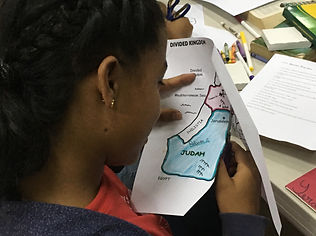
Guia de estudio/Study Guide
su nombre/name ____________________ su edad/age _____________
Direcciones: leer cada pasaje lentamente y piénsalo. Después, contestar las siguientes preguntas. En cada grupo, escoge a alguien que lea las palabras del narrador, Roboán, Jereboán, los ancianos, los jovenes, los israelitas. (Directions: read each passage slowly and thoughtfully. In each group, choose someone to read the words of the narrator, King Rehoboam, King Jerboam, the elders, the young men and the Israelites." After your reading, answer the following questions.
-
I Reyes 12: 1 - 24 (I Kings 12: 1-24)
¿Cuál tribus seguían siendo leales a Roboán? (Which tribes remained loyal to Rehoboam?)
¿Quién hizo Jereboán su rey? (Who made Jereboam their king?)
2. I Reyes 12: 25 - 30 (I Kings 12: 25-30)
¿Jereboam pidió consejo? (Did Jereboam ask for advice?)
¿Qué decisión hizo? (What was his decision?)
¿Fue esta una decisión egoísta o una decisión para honrar a Dios y/o others? (Was it a deci
sion that honored himself or one that honored God and/or others?)
3. El rey Roboán tomó malas decisiones y, como consecuencia, perdió su reino. El rey
Jereboán tomó malas decisiones y vamos a ver que las consecuencias durarán siglos.
La semana pasada, hiciste un gráfico sobre decisiones egoístas y buenas en el tablero.
Trate de pensar en ejemplos muy específicos de decisiones para cada sección. Escríbelos en
la tablera.
King Rehoboam, who began ruling ancient Israel in 930 B.C., made poor decisions and as
a consequence, he lost his kingdom. King Jereboam made poor decisions and we will learn
about the consequences as we study about the following centuries. Last week, you made a
chart showing examples of unwise decisions and also wise decisions. This week, think of
more specific examples and write them on the white board.
